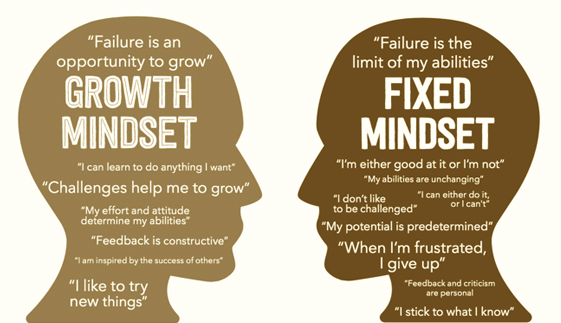
How Mindsets Influence Learning
Picture a parent-teacher meeting where the teacher is explaining how ‘Charlie’ has been progressing in her schoolwork. It comes to the subject of maths and how Charlie is not doing as well as the teacher feels she could. The parent’s response: ‘I’m no good at maths, so that’s probably why Charlie isn’t either.’
Imagine a Year 7 Art class where students are coming to the end of a drawing project. A senior teacher is visiting the class and wanders around looking at the work. He makes a positive comment on ‘Sam’s’ work before he leaves. Once the class is over, the teacher notices one of the projects in the bin and it belongs to the student who was sitting next to Sam.
What is it that causes parents or students to label themselves as ‘not good’ at something?
What is it that causes students to give up when comparing themselves to those around them?
Over the last 40 years, Professor Carol Dweck has been asking these kinds of questions and has discovered that there is a belief we hold about ourselves that can have a significant impact on our ability to learn, adapt and develop. When working with young children in school environments she discovered that they fell into two categories in their approach to schoolwork and learning (Diener & Dweck, 1978). One group had a fixed mindset and the other a growth mindset, each resulting in very different behaviours and learning outcomes for the students. The two mindsets are based on a belief about intelligence and ability to learn.
A fixed mindset believes that basic qualities, traits of personality and intelligence are static and can’t be improved in any significant way. This can lead to students constantly trying to prove how smart they are and avoiding failure at all costs. If someone feels they only have a certain level of intelligence, they will try to make sure they are never perceived as having less than that level.
In contrast, a growth mindset believes that basic qualities, traits of personality and intelligence can be developed and improved. This leads to the student seeing success as thriving in the face of a challenge, and failure as a necessary part of learning and developing new abilities. These mindsets seem to be present from an early age, can be affected by how children are praised by adults (Frome & Eccles, 1998) and determine their relationship to learning, success, and failure.
What is the impact of mindset beliefs?
These beliefs or mindsets have an impact on thinking and behaviour and can be evident in how students engage with their learning. Here are five ways that fixed and growth mindsets can be present:
1. Challenges – students engaging a fixed mindset will tend to avoid challenges and give up easily when work becomes hard. They are less likely to ask for help for fear of seeming deficient. Whereas, students with a growth mindset are more likely to embrace challenges and persist in the face of setbacks, hence why they are more resilient learners.
2. Others’ success – those with a fixed mindsets are more likely to feel threatened by others’ success and may even seek to undermine them. However, growth mindsets are inspired by the success of others and are able to learn from how others achieved.
3. Effort – students engaging a fixed mindset often see effort pointless or as a weakness, and think that learning and skills should come easily. Alternatively, students utilising a growth mindset see effort as necessary for learning. Effort is not seen as a substitute for talent but as a way to become better.
4. Feedback – a fixed mindset encourages rejection of constructive criticism that could help a student improve or learn, whereas those using a growth mindset remain open to feedback and even seek it out.
5. Failure – those engaging a fixed mindset will attempt to avoid failure and mistakes at all costs, as they fear it will show deficiencies. However, those utilising a growth mindset use failure as an opportunity for learning.
Each mindset creates a different meaning for the same situation; one creates a desire for learning and the other a desire for approval (Blackwell, Trzesniewski, & Dweck, 2007).
It is important to note a couple of points about mindsets. Instead of seeing students as being completely growth or fixed, the mindsets exist along a continuum with students exhibiting traits in varying degrees. In addition to this, students may have different mindsets in different areas of life, it is not a label to be applied in all circumstances. Research highlights that teachers and parents can have a significant influence on the development of a growth or fixed mindset in their students and children. (Rattan, Savani, Naidu & Dweck, 2012).
How can you enhance a growth mindset in your classroom or at home?
What do you notice about the language and behaviour of your students and children?
In regards to learning, where do your students and children sit on the fixed – growth mindset continuum?
